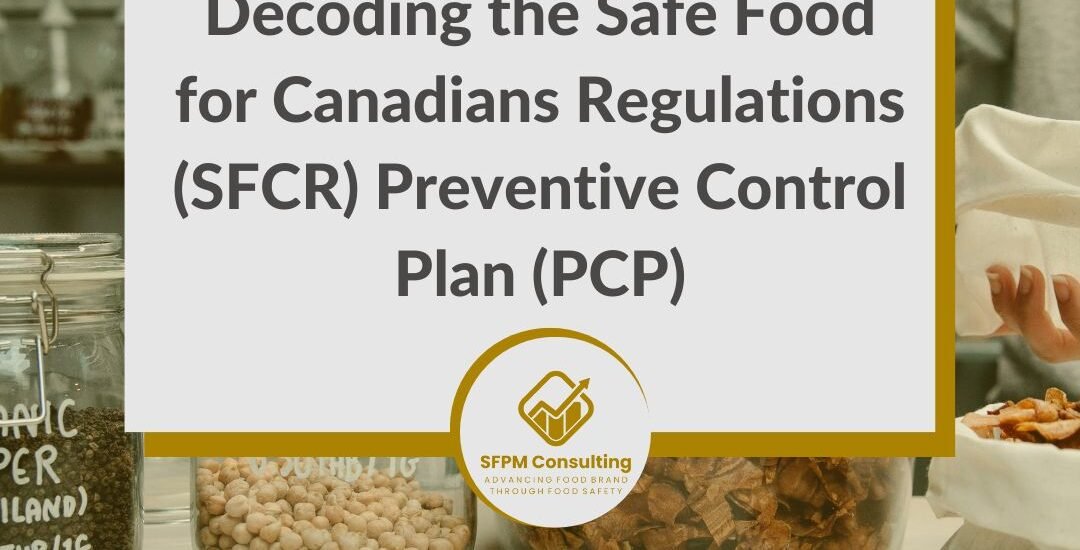Decoding the Safe Food for Canadians Regulations (SFCR) Preventive Control Plan (PCP)
- February 13, 2024
- Posted by: Felicia L
- Categories: Food Exporter, Food Importer, Food Safety, SFCR

Ensuring food safety is of utmost importance for both consumers and manufacturers. In Canada, the Safe Food for Canadians Regulations (SFCR) has been established to provide a comprehensive framework for food safety, traceability, and import controls. One essential component of the SFCR is the Preventive Control Plan (PCP), which plays a crucial role in helping Canadian manufacturers align with these regulations and ensure compliance.
Understanding the SFCR
The SFCR is a set of regulations introduced by the Canadian Food Inspection Agency (CFIA) to modernize and streamline food safety requirements. It applies to all food businesses that import, export, or engage in interprovincial trade. The regulations cover a wide range of topics, including licensing, preventive controls, traceability, and labeling.
The primary objective of the SFCR is to prevent food safety risks and protect consumers from potential health hazards. It places the responsibility on food businesses to implement preventive measures and maintain records to demonstrate compliance.
The Role of the Preventive Control Plan (PCP)
The PCP is a key element of the SFCR and serves as a roadmap for food businesses to identify and mitigate potential risks associated with their products. It is a written document that outlines the steps and procedures a manufacturer will take to prevent hazards throughout the production process.
The PCP must cover several essential components, including:
- Hazard identification: Identifying and assessing potential hazards that may be present in the food product or production process.
- Preventive controls: Implementing measures to prevent or minimize identified hazards, such as sanitation procedures, temperature controls, and allergen management.
- Monitoring: Establishing protocols to monitor the effectiveness of the preventive controls and ensure ongoing compliance.
- Corrective actions: Outlining procedures to address any deviations or non-compliance with the preventive controls.
- Verification: Conducting regular checks and validations to ensure the PCP is being followed correctly and effectively.
- Record keeping: Maintaining accurate and up-to-date records to demonstrate compliance with the PCP.
Aligning with the SFCR and PCP
For Canadian manufacturers, aligning with the SFCR and implementing an effective PCP is essential for compliance and growth. Here are some key steps to consider:
Educate Yourself
Start by thoroughly understanding the requirements outlined in the SFCR and the PCP. Familiarize yourself with the specific regulations that apply to your business, including licensing, preventive controls, and record-keeping obligations. The CFIA website provides comprehensive resources and guidance to help you navigate through the regulations.
Conduct a Hazard Analysis
Identify and assess potential hazards associated with your food products and production processes. Consider biological, chemical, and physical hazards that may pose a risk to consumers. This analysis will form the basis for developing preventive controls within your PCP.
Implement Preventive Controls
Based on the hazard analysis, establish robust preventive controls to minimize or eliminate identified risks. This may include implementing sanitation procedures, establishing temperature controls, segregating allergens, and implementing supplier verification programs. Ensure that these controls are well-documented and consistently followed.
Establish Monitoring Procedures
Develop protocols to monitor the effectiveness of your preventive controls. This may involve regular testing, sampling, or visual inspections to verify that your controls are functioning as intended. Document these monitoring activities and maintain accurate records.
Plan for Corrective Actions
Inevitably, there may be instances where deviations or non-compliance with the preventive controls occur. Establish clear procedures to address these situations promptly. Document the corrective actions taken and ensure that they effectively mitigate the identified risks.
Verify and Validate
Regularly review and validate your PCP to ensure that it remains effective and up-to-date. Conduct internal audits or seek third-party verification to validate your compliance with the SFCR. This will help identify any gaps or areas for improvement.
Maintain Records
Record-keeping is a critical aspect of the PCP. Maintain accurate and up-to-date records of your hazard analysis, preventive controls, monitoring activities, corrective actions, and any other relevant documentation. These records will serve as evidence of compliance and may be requested during inspections or audits.
Conclusion
Compliance with the Safe Food for Canadians Regulations (SFCR) is essential for Canadian manufacturers to ensure food safety and maintain consumer trust. The Preventive Control Plan (PCP) plays a vital role in helping businesses align with these regulations. By understanding the requirements, implementing effective preventive controls, and maintaining accurate records, manufacturers can seamlessly comply with the SFCR and foster growth in the Canadian food industry.
